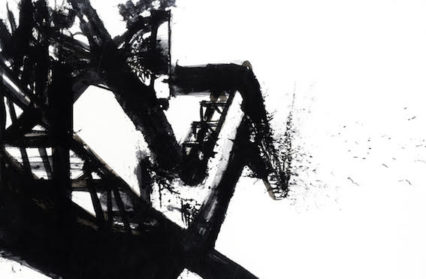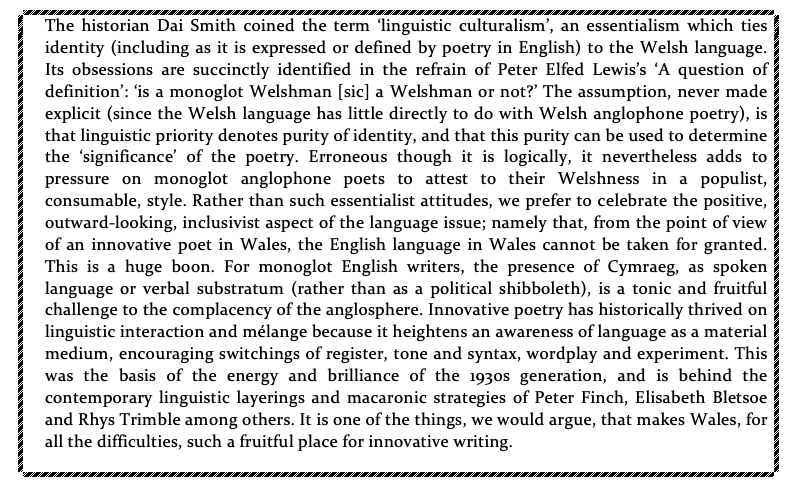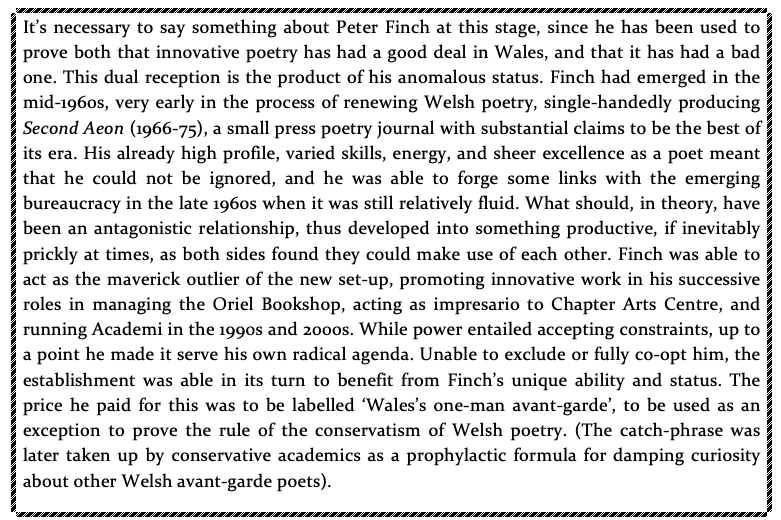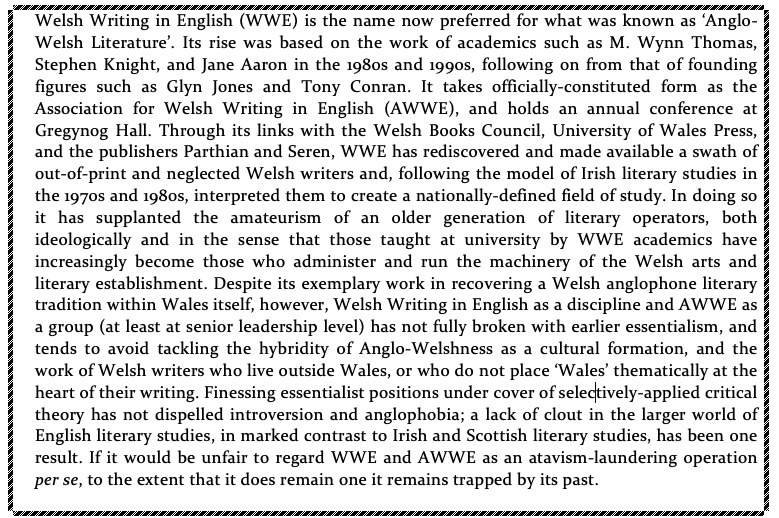Editors John Goodby and Lyndon Davies introduce a ground-breaking new anthology of Welsh poetry that showcases a strong tradition of innovative poets experimentalism, The Edge of Necessary: Wales and Innovative Poetry. In this first extract, the two trace the lines of the Welsh tradition, and the emergence of an anti-establishment school of work.
Innovative poetry in Wales, as elsewhere in Britain and Ireland, has long suffered marginalisation by a mainstream-oriented literary-critical, academic and arts-administrative establishment. In other parts of Britain and Ireland, practitioners of such poetry were able to take refuge, after the fall-out from the ‘Poetry Wars’ of 1976-77, in samizdat support systems of small presses, journals, and readings. However, such networks were sparser, in places non-existent even, in thinly-peopled and under-resourced Wales, and the poets more isolated and ignored than elsewhere. To compound their difficulties, in Wales this institutional neglect was intensified by an ideological opposition to literary experiment of almost any kind. In the eyes of the vast majority of editors, critics and those who made the funding and programming decisions, the function of poetry in Wales, as with literature generally, was – whether this view were explicitly stated or not – to recuperate the past and lay the basis of the nation-to-be. (This cultural nationalism was often interwoven, of course, with the issue of the survival of the Welsh language, usually in ways which skewed poetic and aesthetic issues even further.)
To this end poetry was tasked with limiting itself to traditional metres and forms rather than innovative ones, transparent language use (decorated by the deployment of mild symbolism and metaphor), and realist description – effectively, of pretending that a well-established poetic canon existed, as elsewhere in the British Isles and Ireland, and the duty of poets was to contribute to it. Modernism was a distraction, and Welsh poetry, in both languages, was held to be innately conservative. To disagree or do otherwise was viewed as unnatural and un-Welsh.
The flaw in this schema is glaringly evident; the moment of the birth of anglophone Welsh poetry of note, back in the 1930s and 1940s, had been an explosively modernist one. However, David Jones and Lynette Roberts fell silent in 1952, and Dylan Thomas died in the following year. There followed a decade-long hiatus, out of which a new generation of poets slowly emerged which had to distance itself from the distorting gravitational field of Thomas’s style and reputation in particular, and did so by becoming his stylistic antithesis. The poetry of the ‘Second Flowering’, as it became known, was deliberately flat, downbeat, unexultant, and traditional in form, taking its cue from the realist, empirical poetic espoused by the Movement poets in England, utilising it in the creation of a verse record of Anglo-Welsh experience.
All too aware of the disapproval of many in Welsh-speaking Wales at the time (Saunders Lewis had once described Anglo-Welsh poetry as a contradiction in terms), but responding to the resurgence of nationalism and Welsh language assertiveness, they invoked the traditions of the poet as local communal recorder, orbardd, in Welsh literary genres such as praise poem and cofion (memorial poems), attempting to ingratiate themselves with the older tradition, trying, like the Irish Celtic Twilight writers of half a century before, to replicate at least some elements of it in anglophone form. The subject of this poetry of the backward look was invariably, therefore, local tales, folklore, crafts, traditions, customs, family history, communal struggle and survival, religion, history. It was admirable in its modest way, but even at its best had too much to be modest about.
The ‘Second Flowering’ thus became the basis for an Anglo-Welsh poetic in denial about the modernist origins of anglophone Welsh poetry. The work of Jones was abandoned to a cult. That of Thomas was read largely in terms of his later, more accessible, work. Lynette Roberts, a woman, would be almost completely forgotten. (Later, in the 1990s, with the development of Welsh Writing in English studies as a fully-fledged academic subject, the exclusion or diminishment of these powerful forebears would be given a more theoretical justification.) Out of the Second Flowering and its outriders grew an institutional nexus comprising, alongside the university literature departments, such bodies as The Welsh Books Council, The Welsh Academy, Seren Books, Anglo-Welsh Review and other organs which to a large extent held sway over the administrative, funding, publishing and publicity apparatus of Welsh literature. This critical and financial power-nexus, in many ways a positive development, had, with regard to the shaping of the public perception of what constituted the literary landscape in Wales, less positive effects over the years, promulgating a vision which, generally speaking, could be characterised as conservative (with a small c) and not innovative.
At the heart of this restrictive vision lay a deep anxiety about where the borders lay and who could be allowed to cross them. One of the reasons for this was a fear of anglicisation per se – although, as we have said, the fundamentals of the Second Flowering poetic ironically resembled nothing so much as those of the Movement, a very English phenomenon. Another was undoubtedly as a defensive response to the British Poetry Revival. This was a resurgence of modernist-influenced poetry which drew its energies and examples from US poetry of the 1950s – Projectivist, Beat, Black Mountain, San Francisco Renaissance and New York School. Its key text was Donald Allen’s The New American Poetry 1945-1960 (1960), and its impact in the 1960s was by no means confined to London – one of its distinguishing features was its healthily regionalist aspect, and it flourished in Birmingham, Newcastle, Liverpool, Bristol and Glasgow as much as in the capital.
Another of its features was its reactivation of ‘native’ modernists, such as W. S. Graham, Basil Bunting (whose Briggflatts appeared in 1966) and David Jones (who would publish his last book, The Sleeping Lord, in 1974). All of this had its effect on young poets from Wales as much as those from Scotland, England and Ireland. Among these were John James and Peter Finch, both from Cardiff, the former working outside Wales, in Cambridge, the other inside Wales. By 1966, both were rising to the challenge of these new poetries and making their own voices heard.
It is against this background that a bullish editorial of 1967 in Poetry Wales by Meic Stephens, its then editor, may be understood. All the ‘new [Welsh] poets’ of any ‘significance’, Stephens opined, had to have ‘roots… in a particular community’. They also had to be ‘willing to associate with Welshmen (sic) and have their work discussed with reference to the culture of Wales’, and ‘must be rooted in’ and speak for their ‘communities’. Announcing that Poetry Wales would be overtly ‘nationalist’, Stephens asserted:
‘It worries me to see so many, about a third, of the leading poets resident in England. There is no good reason except “the whistle of the English pound”, to keep Welshmen in London and the English provinces these days and I insist that poets should be the first to live among the people and the scenes they praise, lest all suffer.’
The comments stem from an understandable pragmatic desire to protect a Wales-based poetry scene after decades in which that had been unviable. But the phrasing also registers the fear of a nascent arts bureaucracy that experimentalism challenged its ideological co-ordinates. Put another way, the hybridity, fragmentation and linguistic promiscuity of modernist styles of writing are a mortal threat to any notion of culture and identity based on fixed essences. Stephens’ response to this is to propound an essentialist poetics of belonging which shades into blood and soil atavism.
The reactionary prescriptiveness of the Poetry Wales editorial derives from a monolithic vision, and the singularity of the definite article (‘the culture of Wales’) is revealing. What flows from this is a classic instance of something we will, sadly, find repeated throughout the history of mainstream poetry in Wales – the preparedness to limit, even diminish, the common cultural store in order to maintain one’s rigid conception of how it ought to be (or, in plain English, cut off one’s nose to spite one’s face). This is the only way to explain a preparedness to exclude what are admitted to be ‘leading’ poets simply because they are unwilling to remain in Wales, ‘associate with Welshmen’ and become communal mouthpieces, and the manner in which the sacrosanctness of an anachronistic, narrowly nationalist ideology, is allowed to trump what should be the primary consideration, poetic quality.
Predictably, this was a recipe for disaster. We can see now that the delegitimisation of Welsh diaspora poets, many of them associated with the British Poetry Revival, ensured that, as the 1970s wore on, the ‘Second Flowering’-descended mainstream was sealed in on itself. Increasingly devoid of new ideas, it nevertheless ignored the many important Welsh poets living in England on the grounds that innovative poetry lacked roots, did not sufficiently ‘reflect’ the nation, was ‘foreign’. Even those innovative poets who did possess the necessary residential qualifications were spurned.
Noting the deafening silence that greeted publication of the Cardiffian Gerard Casey’s South Wales Echo in 1973, Tony Conran shrewdly observed: ‘Lip-service was paid to David Jones… but woe betide a poet who followed in his footsteps’. Although the Second Flowering succeeded in renewing its cadre – Gillian Clarke, Nigel Jenkins, Tony Curtis and Robert Minhinnick spring to mind – whatever the technical qualities of the work in question, its aesthetic and ideological standpoint was still very much bound up with the discursive/lyrical/empirical register of orthodox Anglo-Welsh versification. Where there was political radicalism it was never matched with the linguistic radicalism necessary to offer any kind of serious challenge to the settled language of power.
Stephens had prophesied in 1967 that ‘the big danger threatening Anglo-Welsh verse [is that it] may continue to be peripheral, both in Wales and in England’, and, ironically, the poetics he and others espoused meant that this was precisely what happened. The Anglo-Welsh lyric became less innovative, merely formulaic, and mainstream poetry more generally was a pale, Welsh-tinged imitation of the English equivalent. By the 1980s mainstream inability to renew itself was painfully apparent in the fact that its most visible figure seemed, once again, to be R. S. Thomas, a poet born before the First World War. More ironic still was the fact that the only other Wales-domiciled Welsh poet with an international reputation, Peter Finch, was a thoroughgoing experimentalist.
The poor representation of Welsh poets in the Hulse, Kennedy and Morley New Poetry anthology of 1993, and their complete absence from the 1994 New Gen promotion seems to have been a humiliation too far for the 1960s generation’s stewardship of Welsh poetry. This was the point at which the old guard were eased out and serious attempts made to renew the mainstream, aided by a new professionalism and critical rigour. These would largely be supplied by Welsh Writing in English, as it established itself as a subject on the curricula of Welsh universities in the 1990s and 2000s. The dynamism of the Blair government, after eighteen years of Tory rule (which had been particularly harsh and demoralizing in Wales), and the winning of the Devolution vote in 1997, meant the times were propitious for change. Devolution in particular meant that some of the old, polarised ways of thinking about Welsh identity began to crumble. The key buzzwords were ‘pluralist’ and ‘inclusive’, and their promise seemed to be borne out by one of the most notable and hopeful features of 2000s poetry, namely the appearance of a swathe of young women poets (for example, Zoë Skoulding, Deryn Rees-Jones, Rhian Edwards, Sarah Corbett, Samantha Rhydderch, Katherine Gray, and Tiffany Atkinson), and collectively a much-needed challenge to the ingrained gender bias and boyoism which had long disfigured the Welsh cultural scene.
At this point, too, a small group of older poets – Gwyneth Lewis, Robert Minhinnick, Oliver Reynolds and Stephen Knight – enjoyed British, not just Welsh, reputations. Ian Gregson’s The New Poetry in Wales (2007) went so far as to claim that ‘Currently much of the most exciting poetry in Britain is being written in Wales’, making the case for a Welsh mainstream which had at last acquired a critical mass. In 2015, the idea that Devolution had brought about some kind of step-change in the quality of Welsh poetry would even be endorsed by a Leverhulme Trust-funded research project, to the tune of £232,000, The Devolved Voices project at Aberystwyth University.
But how real was this change towards innovative poetry? Mainstream poetry has undoubtedly become brighter and buzzier, as well as more professional and polished, in the last twenty years. In poetic terms, however, it seems to have barely altered, possibly because the mantra of ‘pluralism’, on which it rests, is invariably defined in marketized, consumer terms, not those of poetic value as such. The ‘choices’ on offer have never included that of innovative poetry. As John Matthias put it, commenting on various mainstream anthologies published around the time of the millennium: ‘Ideas of pluralism are extended in these books to race, religion, region, class, language, gender, sexual preference – to everything, in fact, except poetics.’
This statement could be applied with equal force to the Welsh anthology which embodies a similar change-but-no-change position: Meic Stephens’s Poetry 1900-2000: one hundred poets from Wales (2007). For all the pretensions to summation embodied in its title, just five of the forty-six poets in our own anthology are represented in Stephens’s. As for Gregson’s study, even in 2007 ‘excitement’ was not a word many would have associated with Sheenagh Pugh and Duncan Bush, the subjects of his first chapter, while the subjects of three others (Lewis, Minhinnick, and Reynolds) had all found their voices before Devolution. Bizarrely, such gifted figures as John James, Wendy Mulford, David Greenslade, Chris Torrance, Peter Meilleur, Paul Evans and David Annwn do not even rate a mention, let alone discussion. Increasingly, as we examine the makeover of the mainstream in the late 1990s and into 2000s, what we see is evidence not of fundamental alteration, but of a palace revolution, a shifting around of the same old furniture. It is time, then, to look at the real renewal, the one missed by Gregson, and cold-shouldered by Welsh Writing in English studies – namely, that constituted by innovative poetry and poetics, its persistence against the odds, and its recent resurgence.
This anthology of innovative poetry is available now from Aquifer Press.
You might also like…
In Part 2 of this extract from The Edge of Necessary: Wales and Innovative Poetry, editors John Goodby and Lyndon Davies trace the emergence of the modern poetry scene in Wales, charting the evolution of innovative poetry and citing the work of some of the most significant poets of Wales of the last fifty years.
This piece is part of Wales Arts Review’s collection, Dylan Thomas from the Archive.
John Goodby is a Dylan Thomas expert and contributor to Wales Arts Review.















